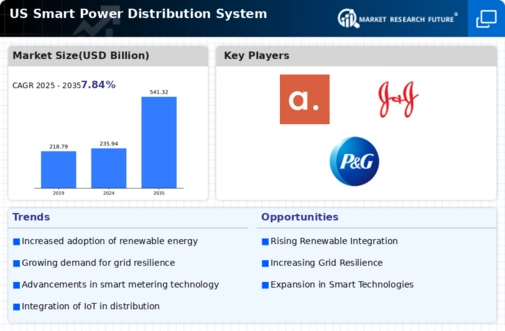Supportive Regulatory Frameworks
Supportive regulatory frameworks are playing a pivotal role in shaping the smart power-distribution-system market. Federal and state policies aimed at promoting clean energy and reducing greenhouse gas emissions are encouraging utilities to adopt smart technologies. The US has implemented various incentives, such as tax credits and grants, to facilitate the transition to smart distribution systems. These regulatory measures are expected to drive investments in the smart power-distribution-system market, as utilities seek to comply with evolving standards and enhance their operational capabilities. The alignment of regulatory support with market needs suggests a favorable environment for the growth of smart power-distribution systems.
Growing Demand for Energy Efficiency
The increasing emphasis on energy efficiency is a primary driver for the smart power-distribution-system market. As consumers and businesses seek to reduce energy costs, the adoption of smart technologies becomes essential. In the US, energy efficiency programs have led to a reduction in energy consumption by approximately 20% in some sectors. This trend indicates a shift towards systems that optimize energy use, thereby enhancing the overall efficiency of power distribution. The smart power-distribution-system market is likely to benefit from this growing demand, as utilities and energy providers invest in advanced technologies to meet consumer expectations and regulatory requirements.
Advancements in Smart Grid Technologies
Technological advancements in smart grid systems are significantly influencing the smart power-distribution-system market. Innovations such as real-time monitoring, automated fault detection, and advanced metering infrastructure are becoming increasingly prevalent. In the US, investments in smart grid technologies are projected to reach $100 billion by 2025, reflecting a robust commitment to modernizing the electrical grid. These advancements not only improve operational efficiency but also enhance the reliability of power distribution. Consequently, the smart power-distribution-system market is poised for growth as utilities adopt these technologies to better manage energy resources and respond to consumer demands.
Rising Consumer Awareness and Engagement
Consumer awareness regarding energy consumption and sustainability is on the rise, influencing the smart power-distribution-system market. As individuals become more informed about their energy usage, there is a growing demand for systems that provide real-time data and insights. This trend is evident in the increasing adoption of smart meters and home energy management systems across the US. Approximately 50% of households are expected to have smart meters by 2026, facilitating greater consumer engagement in energy management. This heightened awareness is likely to drive the demand for smart power-distribution systems that empower consumers to make informed decisions about their energy consumption.
Increased Investment in Infrastructure Modernization
The need for infrastructure modernization is a critical driver for the smart power distribution system market. Aging electrical grids in the US require substantial upgrades to meet current and future energy demands. The US government has allocated over $30 billion for grid modernization initiatives, which include the deployment of smart distribution systems. This investment aims to enhance grid reliability, reduce outages, and integrate renewable energy sources more effectively. As utilities and municipalities prioritize infrastructure improvements, the smart power-distribution-system market is likely to experience significant growth, driven by the demand for modernized and resilient power distribution networks.













Leave a Comment